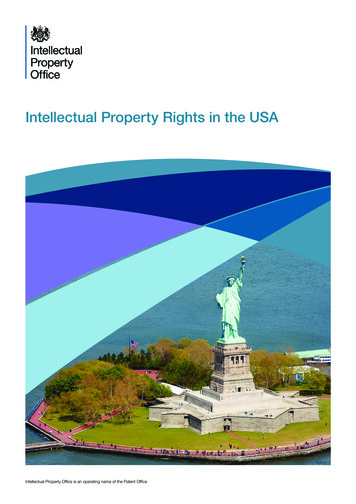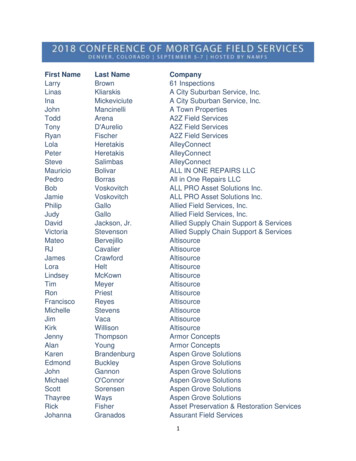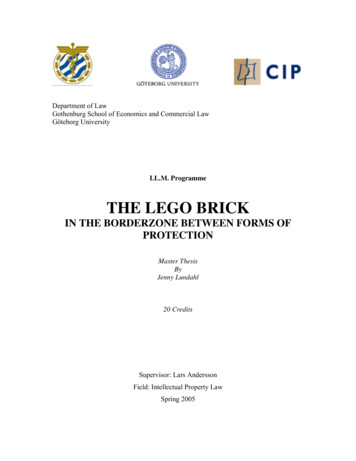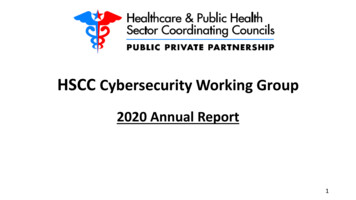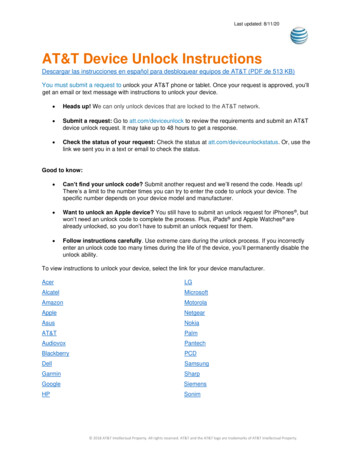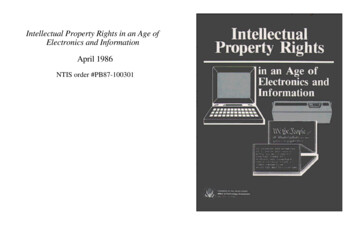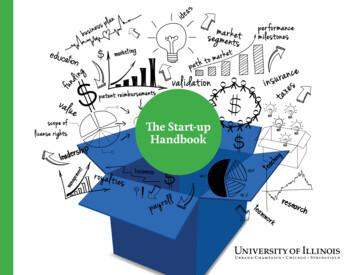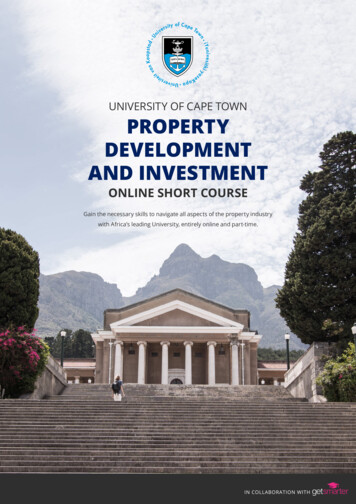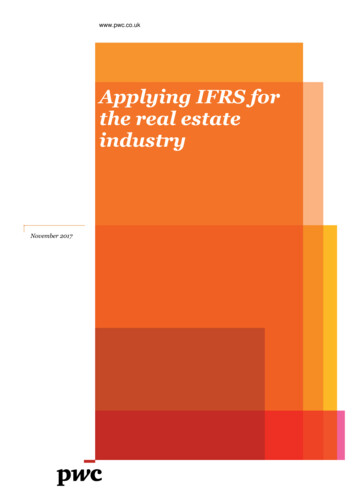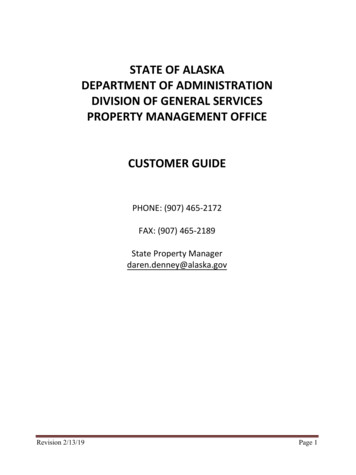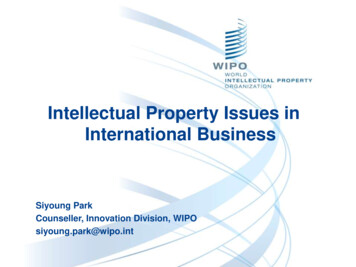
Transcription
Intellectual Property Issues inInternational BusinessSiyoung ParkCounseller, Innovation Division, WIPOsiyoung.park@wipo.int
List of Contents1General Intellectual Property Issues2PCT3Madrid
3General Intellectual Property Issues
4Just as in the National Context .Exclusivity provided by the IP system essentially allows the owner toprevent others from using the IP rightsIt is said that imitation is the most sincere form of flattery. IP can reduceyour chance of being flatteredIP enables businesses to use it to:Create differentiation and add valueCommand higher prices and sustained demand through brandloyalty, new and/or improved features, captivating designs .Attract partners and investorsAccess new markets and generate new sources of revenue throughlicensing and other partnershipsPersuade investors. . . IP is an important consideration in international trade
5Contents: IP Issue Areas to beConsidered in International TradeIP Rights are TerritorialSecure Freedom to OperateRespect DeadlinesEarly DisclosureWorking with PartnersChoosing an Appropriate Trademark
6IP Rights are TerritorialIt is important to keep in mind that IP rights are onlyvalid in the country or region in which they have beengranted. Therefore, applying for such rights in othercountries is important if there is an intention to gointernational.However, notecopyright is automatically available through theprovisions of the Berne Convention,famous marks have automatic protection,trade secrets are by their nature confidential.
7IP Rights are Territorial - Obtain IPRights Internationally - National RouteNational route - Apply in each country, pay fees,translation into national languages
8IP Rights are Territorial - Obtain IPRights Internationally - Regional RouteBenelux Office for IP (TM and Designs)African Regional Industrial Property Office (ARIPO)Eurasian Patent OfficeEuropean Patent OfficeOffice for the Harmonization of the Internal Market (TM andDesigns)Organisation Africaine de la Propriété Intellectuelle (OAPI)Patent Office of the Cooperation Council for the Arab States ofthe Gulf
9Obtain IP Rights Internationally International RouteWIPO Administers the Madrid, Hague and PCT Systems for theinternational registration of marks, designs and patentsMadrid and Hague – international application valid in thedesignated countries unless rejected within a specified timePCT – international application subject to international phase(international search and patentability report – and apreliminary examination report, if required) followed by thenational phase. Here the designated countries decide onpatentability
10Freedom to Operate (FTO)Analyzing FTO is to evaluate whether you are in any wayinfringing the patents, designs or trademarks of others.Such a evaluation is usually done by conducting a search inpatent, trademark and design databases for patent applications,granted patents, registered trademarks or designsAs patents, trademarks and designs are granted to particularterritories an FTO search may reveal that the particular IP inquestion is not protected in the territory of interest
11FTO – Conducting SearchesReason for conducting searches:Example 1: same or confusingly similar trademark mayalready exist in the export marketExample 2: technology not patented in one country may bepatented elsewhereExample 3: FTO opinion to leave a paper trail showing effortto avoid infringementMust SearchNational or Regional Offices
12www.wipo.int/wipogold/en/
13
14
15
16FTO - PatentEven if there is a potentially conflicting patent that has beengranted in the territory in questionIt may have expired or expiring soonIts claims may not cover the elements of interestIf the patent still remains valid and applicableIt could still be invalidated by finding applicable prior artA license could be obtained orInvent an alternative .!
17FTO - TrademarkSame issues nationally as for international:Search for similar trade name or domain name that may lead toa future dispute.Look at the trademarks being used by the main competitors inthe export market to ensure that they are not using trademarksthat may be considered to be confusingly similar to yours,even if they have not registered them.
18In case of conflictIf the search produces a prior existing patent, trademark or designin the market of interest then clearly it cannot be used as is.Options available are to change the trademark, design around thepatent or design, offer to buy or license that right or challenge itsvalidity
19Respect DeadlinesPriority PeriodOnce an application for a patent or design right has been madedomestically (priority date) an international application has to bemade within the “priority period.” The international applicationwill benefit from the priority date. A filing after the priority periodhas lapsed would mean you can’t benefit from the earlier prioritydate and novelty will be lost.Patents: 12 monthsDesigns: 6 months
20Risks of Early DisclosurePatents and designs are required to be novel to merit protectionIf a product needs to be disclosed it should be done in aconfidential context Non-disclosure Agreement.If not, the novelty could be lost and an application for registrationbe rejectedThis is particularly important in disclosing products that embodyinventions and/or designs to potential partners before protectionhas been obtained
21Working with PartnersOwnership of IPCreation of new IP and who owns thatAssignments/licenses for ownershipRisk of unauthorized use or disclosure of trade secrets by partnerRisk that partner will use trade secrets of others and expose you tolitigation. Insist on indemnificationQuality of product to be maintained so as to sustain brand imageTrade marks if registered in the partners name in the countrycould create problems once the relationship ends
22Suitability of TrademarksCheck whether the mark has undesired connotations or is likely tobe rejected in that countryMitsubishi was dismayed to find that PAJERO means 'wanker' inSpanish. Ford NOVA means no go in Spanish. Whereas CocaCola was successful in finding a trademark in Chinese to say“happiness in the mouth”
23ConclusionIP is of relevance to many aspects of international tradeCrucially it provides exclusive rightsBut these rights have to be pursued locally and internationallyso as to prevent imitatorsBe mindful of the additional issues of relevance tointernational trade
24PCT
25General remarks on the PCTThe PCT system is a patent “filing” system, not a patent“granting” systemThe PCT system consists of an international and national phaseThe decision on granting patents is taken exclusively by nationalor regional Offices in the national phaseThe PCT is administered by the International Bureau of WIPO
26PCT:“The PCT helps put innovation into practice byproviding a simple and cost-effective wayto file international patent applications”Paul Jacobs, Chairman and CEO, QualcommQualcomm: US 14.96 billion revenue (2011)17,500 employeesMore than 9,000 PCT applications filed
27
28
29The PCT System(months)0File localapplicationTypically a nationalpatent application inthe home country ofthe applicant12File ionalsearch report& demand ternationalpreliminaryreport onpatentability30
30The PCT System(months)012File localapplicationFile ionalsearch report& writtenopinionTypically filed in samenational patent office--oneset of fees, one language,one set of formalityrequirements--and legaleffect in all PCT StatesEnternationalphase2228(optional)Filedemand ternationalpreliminaryreport onpatentability30
31The PCT System(months)012File localapplicationFile ionalsearch report& writtenopinionReport on state ofthe art (prior artdocuments and theirrelevance) initialpatentability opinionEnternationalphase2228(optional)Filedemand ternationalpreliminaryreport onpatentability30
32The PCT SystemDisclosing to worldcontent of applicationin standardized way(months)012File localapplicationFile ionalsearch report& demand ternationalpreliminaryreport onpatentability30
33The PCT System(months)012File localapplicationFile ionalsearch report& mand forInternationalpreliminaryexaminationRequest an additionalpatentability analysis on basisof amended ort onpatentability30
34The PCT System(months)012File localapplicationFile ionalsearch report& ledemand ternationalpreliminaryreport onpatentabilityAdditional patentabilityanalysis, designed to assistin national phase decisionmaking
35The PCT SystemExpress intentionand take steps topursue to grant invarious states(months)012File localapplicationFile ionalsearch report& demand ternationalpreliminaryreport onpatentability30
36PCT international phaseUnified filing procedure consisting of the filing and processing ofa single application with legal effect in all PCT Contracting StatesInformation on the potential patentability of an invention prior tothe start of national patent procedures (“national phase”)Publication of the international application together with theInternational Search Report (ISR)Time delay of at least 30 months before the start of the nationalpatent procedure
37PCT national phaseGateway to national patent systemsGrant (or refusal) of a patent by national or regional Offices
38The PCT SystemChapter I20(months)012File localapplicationFile rch Reportand WrittenOpinion of theISASISrequest(optional)or, optionalFile demandInternationalPreliminaryExaminationChapter II
39International searchPerformed by an International Searching AuthorityPCT Minimum Documentation (PCT Rule 34)Everything which has been made available to the public,anywhere in the world, by means of written disclosure
40International Search Report (ISR)IPC (International Patent Classification) symbolsIndications of the technical areas searchedIndications relating to any finding of lack of unityA list of the relevant prior art documentsIndications relating to any finding that a meaningful search couldnot be carried out in respect of certain (but not all) claims
41International Search Report (ISR) (2)Time limit to establish ISR and Written Opinion of the ISA3 months from the date of receipt of the search copy by theISA (usually within approximately 16 months from thepriority date if priority is claimed); or9 months from the priority date, whichever time limit expireslater
42Example of an ISRSymbols indicatingwhich aspect ofpatentabilitythe document cited isrelevant to (forexample, novelty,inventive step, etc.)Documentsrelevant towhether or notyour inventionmay be patentableThe claim numbersin your application towhich the document isrelevant
43Written Opinion of the ISAA preliminary non-binding opinion on novelty, inventive step(non-obviousness) and industrial applicability (utility)Established at the same time as the ISRNot published at 18 months but made available to the public onPATENTSCOPE after 30 monthsNo formal response procedure although applicants may submitinformal comments
44Example of the Written OpinionPatentabilityassessmentof the claimsReasoningsupporting theassessment
45International Preliminary ExaminationOptional procedureRequested by filing a demand with an International PreliminaryAuthority (IPEA) (same list as ISA)Results in the issuance of a preliminary, non-binding opinion bythe IPEA on novelty, inventive step and industrial applicabilityInternational Preliminary Report on Patentability (Chapter II)– IPRP Ch.IIOpportunity to amend the description, claims and drawings toaddress objections raised by the ISA
46Amendment proceduresChapter IArticle 19 amendmentsOne-time amendment of the claims before the InternationalBureau after receipt of the International Search Report (ISR)Chapter IIArticle 34 amendmentsAmendment of the claims, description, drawings before theIPEA to address objections raised by the ISA
47Entry into the national phaseThe international phase ends after 30 months from the earliestfiling dateThe applicant typically has to decide prior to this time in whichcountries to enter the national phaseThe PCT provides an option for 146 Contracting StatesBased on experience, applicants would enter the national phase inno more than 30 countries (between 5 and 30)
48Decisions to be taken by the applicantWhether to proceed with or abandon the international application?When?At the end of 30 monthsWhere?Choice of countries/regions based on business and localmarket conditions
49Some national phase requirementsmay applyPayment of national feeTranslation, if applicableCopy of international application in particular circumstances onlyOther special national phase requirements which may apply are tobe complied with at the time of national phase entry or within atime limit fixed by the national Office
50Cost deferralSeeking patents in foreign countries requires a significant capitalinvestmentThe PCT provides for the deferral of main initial costs associatedwith internationalizationCost of translationsLocal patent agent feesLocal patent Office fees
51Patentability analysisStrong basis for patenting decisionsValuable information that is of assistance in making patentingdecisionsThe International Search Report (ISR) and the Written Opinion ofthe International Searching AuthorityInternational Preliminary Report on Patentability(IPRP (Ch.II)) of the International Preliminary ExaminingAuthority (optional)
52Madrid
53Protection of TrademarksObtained through registration or use, but strong protection may be obtained only through registrationThe right arising from registration has a territorial characterregistration is subject to the national legislation of the countryFiled with the competent authorities (IPO)If you want to have your mark protected abroad, you have to registerthe mark in all the countries where protection is desired
54Routes for Protecting a Trademark abroadThe national route or direct filing: Filing applications with thetrademark office of each country in which protection of the mark issoughtThe regional route: Applying for protection in countries which aremembers of a regional trademarks registration system with effect inthe territories of all Member states (ARIPO, Benelux TrademarkOffice, OHIM and OAPI)The international route: The Madrid System
55National Route vs. Madrid RouteApplicantApplicantOffice of CABC
56Legal Framework IMadrid Agreement (1891) latest revised in 1979Madrid Protocol (1989) latest revised in 2007Common Regulations as in force fromSeptember 1, 2009Administrative Instructions as in force fromJanuary 1, 2008Law and Regulations of each Contracting PartySee at http://www.wipo.int/madrid/en/legal ces info.html
57Legal Framework IIUnder the Madrid systemTreaties and Regulationsproviding the basic principles and mechanism of thesystem; governing the formal conditions for an internationalregistrationDomestic Law and Regulations of a Contracting Partygoverning the substantive conditions for granting theprotection in each relevant territory
58National or International/Madrid Route?National Route Many Offices for filingMany application formsMany languagesMany currenciesMany registrationsMany renewalsMany modificationsForeign attorney needed frombeginningMadrid RouteOne Office for filingOne single application formOne language (E/F/S)One currency (Swiss francs)One international registrationOne renewalOne modificationForeign attorney needed onlyin case of refusal
59General Procedure under the Madrid SystemApplicant filesbefore Office of originwhich certifies theapplication andforwards it to WIPOWIPO performsformalexamination,registers andnotifies designatedContractingPartiesDesignatedOffices makesubstantiveexaminationand grant orrefuseprotectionWIPO recordsand notifiesholderHolder hasequal rights asif he had fileddirectly
60International Registrations – an OverviewWIPOOffice oforiginSubstantiveexaminationDesignatedOffice18 Months2 MonthsDate ofInternationalregistration2 Months(average)Time limit forprovisionalrefusal10 yearsRenewal(every 10 year)
61The Madrid SystemA centralized filing mechanismA one-stop shop for trademark holders to obtain and maintaintrademark protection in export marketsAn option to the national routeA purely procedural treatyThe domestic legislations of the designated Contracting Parties setthe conditions for protecting a trademark and determine the rightswhich result from protection
62Basic Features (1)EntitlementAn international application may be based on one or moreapplications or registrationsThe fees payable in connection with the application The basic fee (CHF 653 or 903) A complementary fee for each designated Contracting Party withsupplementary fee OR individual feeScope of protection – to be determined by designated ContractingPartyThe Contracting Party may elect for 12/18 months refusal period
63Basic Features (2)Statement of grant of protectionSubsequent designationThe 5 years dependency period Central attack – Ceasing of effectsTransformation of the International registration into nationalapplications10 years term of protection with renewal every 10 years
64Benefits for Trademark OwnersSimple- A single set of simple formalities- A single filing OfficeLow-Cost- Low registration fees- No need to pay foreign agents for filings- No need to pay translation of the paperwork into several languagesEffective- A single international application produces the same legal effect invarious countries- A fixed deadline for the confirmation or refusal of the legal effects ineach designated country
65Benefits for the Offices and GovernmentThe Contracting Parties can focus on substantive examinationThe Madrid system has a positive effect on economic growthIt empowers SMEsIt promotes international trade by contributing to the opening of newmarkets and assisiting in development of exportIt creates a more favorable climate for foreign investment in theinternal market
66International Registration ProcedurePrecondition: basic application or basic registrationOFFICE OFORIGININTERNATIONALBUREAUOFFICE OFDESIGNATEDCONTRACTINGPARTYOFFICE OFDESIGNATEDCONTRACTINGPARTYCertifies entitlement/basicmark and forwards theapplication to the IBFormal examinationRecords in the International RegisterPublishes in the International GazetteNotifies designated Contracting PartiesSubstantive ExaminationGrant of protection effect of nationalregistrationProvisionalrefusal withintime limits?
67Siyoung ParkCounsellor, Innovation Division, WIPOsiyoung.park@wipo.int
International Business. List of Contents 1 2 General Intellectual Property Issues PCT 3 Madrid. 3 General Intellectual Property Issues . Just as in the National Context . Exclusivity provided by the IP system essentially allows the
